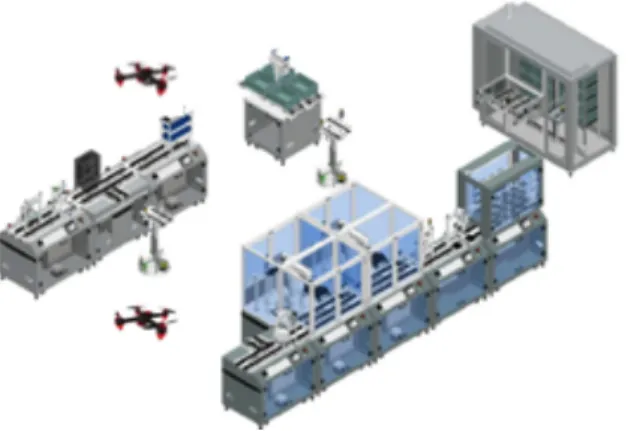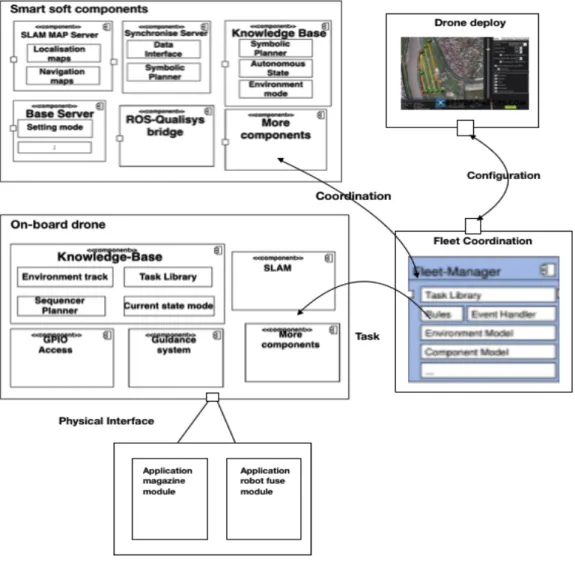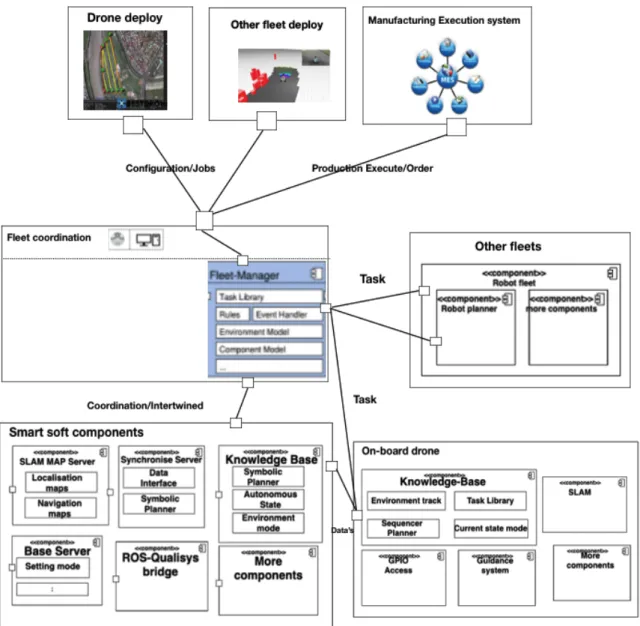HAL Id: hal-03011568
https://hal.archives-ouvertes.fr/hal-03011568
Submitted on 18 Nov 2020HAL is a multi-disciplinary open access
archive for the deposit and dissemination of sci-entific research documents, whether they are pub-lished or not. The documents may come from teaching and research institutions in France or abroad, or from public or private research centers.
L’archive ouverte pluridisciplinaire HAL, est destinée au dépôt et à la diffusion de documents scientifiques de niveau recherche, publiés ou non, émanant des établissements d’enseignement et de recherche français ou étrangers, des laboratoires publics ou privés.
drones in a cyber-physical factory
Puviyarasu Subramaniam Anbuchezhian, Farouk Belkadi, Catherine da
Cunha, Abdelhamid Chriette, Alain Bernard
To cite this version:
Puviyarasu Subramaniam Anbuchezhian, Farouk Belkadi, Catherine da Cunha, Abdelhamid Chriette, Alain Bernard. A semantic interface model to support the integration of drones in a cyber-physical factory. INTERNATIONAL CONFERENCE ON INTEROPERABILITY FOR ENTERPRISE SYS-TEMS AND APPLICATIONS (IESA), Nov 2020, Tarbes, France. �hal-03011568�
A semantic interface model to support the integration of
drones in a cyber-physical factory
Puviyarasu S. A[0000-0001-7028-9493] , Farouk Belkadi[0000-0003-2783-4147], Catherine da
Cunha[0000-0002-1330-8384], Abdelhamid Chriette[0000-0003-4457-1561],
Alain Bernard [0000-0002-7037-2980]
Ecole Centrale de Nantes, LS2N-UMR 6004, France. Puviyarasu.sa@ls2n.fr
Abstract. Industries rely on digital transformation and emergent technologies in order to reach processes efficiency and flexibility. Cyber-physical systems are currently proposed as an answer to this fourth industrial revolution. In this context, the use of drones can offer new opportunities in manufacturing shop floors. However, the adoption of such technologies requires the development of integrated interfaces to solve interoperability issues between the different components of the global production system. This paper addresses the problem of interfacing through a conceptual interface model representing the exchanged data flows between drones and a given production system. It is instantiated on a real experimental 4.0 platform combing production modules and drones.This model aims to support communication between the related logical and software components. This work is a required step in order to later address the interoperability issues.
Keywords: Cyber-Physical System (CPS), Interface model, Production
system, drones.
1
Introduction & Problem statement
Industry 4.0 is mainly about new innovative business models embracing the new possibilities offered by new technologies. Cyber-physical systems (CPS) are currently proposed as an answer to the new industrial revolution. The main characteristic of CPS is a coupling of physical and cyber components with a networked connection [1]. It involves computational elements able to operate on different scales and interact with each other when a change in context. The CPS technology and application for production is termed, as cyber-physical production system (CPPS) for the last few years [2]. They offer an effective and productive system by enabling smart manufacturing. The CPPS controls and integrates with various smart devices and information systems with standard interfaces [3]. Incorporating drones into industry offers new reliable industrial applications, not only transportation but also for inspection and data gathering activities [4].
A real smart platform 4.0 is used as a case for integrating the devices with existing systems. The cyber-physical factory (CP Factory) includes advanced technologies with
networked connected modules [5]. In this context, we incorporated a new drone system for material transportation applications. However, adopting such technologies with the existing complex system raises interface issues. In particular, interfacing problems between the different components of the global production system requires to develop an integrated approach. These issues need to be addressed before tackling interoperability issues. The model-driven architecture (MDA) approach will be followed. It is traditionally used to identify the integration or interoperability of the system from the conceptual description and to the implementation [6]. MDA is a set of guidelines for structuring the specifications and issues at each abstraction level of system integration. They are expressed in models to facilitate the trans-level of systems. This paper describes a conceptual interface model to represent communication between the system’s logical component and software level. The complete collaborative existing and proposed interface model of a CP factory is shown. The proposed conceptual semantic interface model is the first step to future physical implementation.
Section 2 describes the state of the art of current issues and ongoing developments of drone integration. In section 3, a short description of the system architecture and analysis is proposed. The proposed semantic interface model at logical and software levels is discussed in section 4. Finally, conclusions are drawn and future works identified.
2
State of the art
Industry 4.0 combines the virtual and physical world of production, machines, systems, and sensors to communicate with each other, to share information, and control each other independently [5]. Cyber-physical systems (CPS) are systems in which the collaborating physical and software components are deeply intertwined, able to operate and interact with each other were change in context. The Cyber-physical factory (CP Factory) has a highly complex and digital production that provides the smart factory platform. The CPS applications for production integrate state of the art technologies and reinforce technology interactions [7]. Flying drones are increasingly popular for the industrial context and it offers new possibilities for transforming industries. Drones can operate without any human intervention for prolonged periods and can recognize with a full 360 degrees overview industrial objective [8]. They are becoming popular intelligent logistics tools in manufacturing and other industries. For instance, Amazon introduced the prime air for the commercial delivery of shipping products to customers [9]. Load transportation and deployment by drones are handy for many applications including the delivery of packages, delivery of isolated victims in disasters (floods, earthquakes, fires, industrial disasters and many others. It is also a fundamental technology for other future applications [10]. With increased technological capabilities and connectivity, drones are one of the latest technologies to fit into the industry, at various stages.
3 However, incorporating a drone into a CPPS is a challenging task in terms of interoperability [11]. These technologies and application for the industry would first require the installation and supporting units defining the interoperable connectivity that fit into another system [12]. Drones and their interoperability represents one of the most important areas of innovation across the technology industry [13]. To tackle the interface and interoperability problem at each abstraction level, the model-driven architecture (MDA) helps to solve the issue of the system. The use of this approach allows a complete follow-up from expressing system interface and interoperability requirements to solution coding [14]. Therefore appropriate models, matching the particular objectives should be used. Semantic approaches can help to reunite the objectives and facilitate interoperability irrespective of the domain. The semantic model is the process of interrelation information and systems from diverse sources and facilitate (or even automate) the communication between the software and components [15]. Below section shows and discussed the semantic interface of diverse source and facilitate the communication exchanges between the different modules in the CP factory. Next section describes the system architecture and analysis,
3
System Architecture and Analysis
This section presents a short overview of the cyber-physical production system and flying drones deployed in the LS2N1 laboratory. Figure 1 shows the targeted future
scenario in the CP factory with a drone. Each system has its own architecture and functionality to perform its allocated task. Only the initial description of each system is discussed below.
3.1 CP Factory
The CP factory reflects the Industry 4.0 production paradigm by offering a modular CPPS. The platform is based on a FESTO standard solution. The core of the system is its modularity, which enables great edibility by combining modules in different configurations for a variety of applications [5]. This system assembles mobile cases in a standard and customized way. The final product and its components are small and light: fuses, printed circuit board, bottom, and upper cover. The system includes various assembly stations, warehouses, and various application modules. The basic module has different functionalities corresponding to the application module. The current CP factory uses humans and mobile robots for material transportation. An MES (Manufacturing Execution System) executes the operations. The other fleet-deploy processes the operation of the mobile robot by navigating the boundaries, data and signal processing. Those elements can work separately and a platform called “Fleet manager” coordinates their interactions. The software components of these systems are deeply intertwined to support the global assembly process.
3.2 Flying drone
The flying drone has a standard architecture composed of Raspberry Pi, Pixhawk, vision board camera, guidance system, proximity sensor, parallel motion 2-jaw gripper, suction gripper, and more. Generally, the drone software comprises various dimensions controlling platform, mapping and cloud-based platform [16]. The primary issue for the indoor application of the drone is the localization and mapping. SLAM (Simultaneous localization and mapping) approach is being developed to address these issues [17]. A more detailed description of the system is out of scope for this paper.
3.3 Integration scenario
In this work, we want to use the drone for the transportation tasks done by humans in the current situation: fuses and top covers Magasin filling (cf. Fig 1).
Fig. 1. Target Scenario in the Platform
The feasibility analysis is done at the physical and also software level. The requirements of the possible use-case scenario for the various modules of the platform have been identified. The physical interfaces between drone and CP factory are “magazine application module” and “fuse application module”. The software interfaces are the existing fleet coordination and smart-soft components of a drone. The results of the feasibility analysis confirm that the target scenario can be implemented. However, it requires a semantic component level integration and the development of transfer units of the application module corresponding to drone physical interfaces.
5
4
Proposed semantic Interface model
The semantics framework serves many purposes, from structuring to solving the interoperability issues. It assists in identifying the scope to build shared data resources or information exchanges. The semantic model helps at each abstraction level to incorporate the new possibilities of integration of the system. The proposed semantic interface model is at two levels: logical component and software.
4.1 Semantic Interface Architecture-Logical component level
In this section, the semantic interfacing relationship between the system’s logical component level is proposed for the material transportation application. The proposition considers the actual ports of the existing system but only at the black-box level. From the drone system point of view, the coupling and decoupling of material for each application module are the same. However, each application module has a different type of physical transfer unit. It may affect the component level interface with a new device. Figures 2 and 3 show the conceptual logical component interface model proposed for the target system, modeled using SysML2. The interface model shows the
common communication relationship between both systems in order to perform a task. The logical component and port of the system should have fine adjustments for docking-undocking the fuses. Laser retroreflectors (a technology already used in the CP Factory) will ensure the interoperable communication between the ports of components. Firstly, figure 2 shows the interface model of logical components between the fuse application module and the drone.
Fig. 2. Fuse application module-Drone logical interface model
Secondly, figure 3 shows the interface model of logical components between the magazine application module and the drone.
Fig. 3. Magazine application module-Drone logical interface model
4.2 Semantic Interface Architecture- Software level
Section 3 summarizes the existing CP factory software components and the feasibility of the target scenario. This section specifies the interface architecture of the software level component to support the goal. The visual representations use UML’s component diagram syntax.
4.2.1 Smart soft component of the target system
The drone system has various dimensions in the software level, which includes end-user software, robot operating software, operating software, and a cloud-based control platform. The emerging smart soft is a component approach for drone software development and software-based communication patterns, which is a core for drone’s component modeling [17]. Using these distributed components, the communication patterns predefine the semantics of the interface of components, irrespective of where they applied [18, 19]. For our target system, the smart soft approach is used on diverse components namely: guidance system, knowledge-base, SLAM (Simultaneous localization and mapping) map server, base server, and docking-undocking mode, synchronize state. These components are predefined intelligence of drones. Figure 4 shows the conceptual semantic interface model of drone. This model defines interfacing components and their communication exchange between the different components. From the fig, it is shown that the smart soft components of the drone are intertwined and coordinates with the fleet manager to exchange the predefine intelligence of drone.
7 Then drone deploys which is another application used to configure the drone and support the processing, mapping, and exchange of other dynamic information with the fleet manager. The collaborative semantic interface model and their communication exchanges for the global target scenario (Figure 1) are presented in the following section.
Fig 4. Proposed interface model for the drone
4.2.2 Collaborative semantic interface model of the target system
The proposed collaborative semantic interface model gives a feasible and preliminary solution to integrate drones in the CP factory. This section shows the existing system
software components and specifies the collaboration interactions with the proposed system semantic model at the software level.
Fig. 5 Proposed collaborative semantic interface model for the global target system
Figure 5 shows the collaborative interface model at the software level of the target system. Manufacturing Execution System (MES), other fleet deploys, fleet managers, other fleets are the existing software components in CP Factory. The drone deploys, smart soft components, onboard components are the drone software components.Three
9 collaborative interactions between existing and drone software levels for the targeted scenario in CP Factory are proposed. 1) Fleet manager performs the coordinative functionality of data processing, mapping, environment positioning, configuration of the system (drone deploys, other fleets, MES). For example, the drone deploys sends the drone initialized command to the fleet manager. The command helps the fleet manager position the drone for transportation. (2) The smart soft components of mobile robots and drones are deeply intertwined with fleet coordination. For example, the task library of the fleet manager receives and synchronize the predefined intelligence of drone for docking and undocking the materials.(3) In order to perform a global task of the production process, the interoperable information exchanges of (1) & (2) shares the configuration information, predefined intelligence of the system. For example, synchronization of production tasks with drone task. These three collaborative communication exchanges at the software level for the targeted scenario are necessary to perform reliable drone transportation.
5
Conclusion and future work
This paper addresses the integration of drones in a cyber-physical factory, as a starting step to create new possibilities for reliable transportations. This paper describes the semantic interface model and the interactions between elements of the system. In this work, we identified the interfacing components and communication exchanges between the drone and the production system. Then, we proposed the semantic interface model on the logical component and software application levels using MDA. From the identified communication exchange interface requirements are identified. It is the required step to analyze and address the interoperability problems further in future work. Finally, the design and realization of the interoperability between the different components at physical (for eg, coupling sensors) and software (for eg, synchronization, drone task planning) level of the system will be achieved.
6
References
1. Christopher Greer, Martin Burns David Wollman Edward Griffor, Cyber-physical systems and Internet of things, National institute of standards and technology, Special Publication 1900-202.
2. Olivier Cardin. Classification of cyber-physical production systems applications: Proposition of an analysis framework. Computers in Industry, Elsevier, 2019, 104, pp.11 - 21. ff10.1016/j.compind.2018.10.002.
3. Andrea Capitanelli, Alessandra Papettia , Margherita Peruzzinia , Michele Germani, A smart home Information Management model for device Interoperability simulation, Procedia CIRP Vol 21, 2014, pp 64-69.
4. Catalin Gheorghe Amza, Doru Cantemir; Ioana Cantemir et al. “Guidelines on Industry 4.0 and drone Entrepreneurship for VET students”, Danmar Computer LLC ul.K. Hoffmanowej 19-35-016, Rzeszow 2018.
5. Festo didactic cyber-physical factory, A universal Industry 4.0 training factory. A guided tour on the learning industry 4.0 system, doi 1058@ 2016/12.
6. Bourey JP, Grangel R, Doumeingts G, Berre A (2007), Deliverable DTG2.3 from the INTEROP project. Report on Model-Driven Interoperability. http://interop-vlab.eu. Accessed 15 May 2013
7. Fazel Ansari, Phillip Hold,Wilfried Sihn, Human-Centred cyber-physical production system: How does industry 4.0 impact on decision making tasks? IEEE Technology and Engineering Management Conference,2018.
8. Konstantin Kondak, Anibal Ollero et al, Unmanned Aerial Systems Physically Interacting with the Environment. Load Transportation, Deployment and Aerial Manipulation, Springer link, Handbook of unmanned aerial vehicle, pp 2755-2785
9. Holland Michel, “Amazon’s drone Patents”, Center for the study of drone, September 2017. 10. Oldrich Faldick, Richard Payne, John Fitzgerald, Barbora Buhnova, Modelling systems of systems Interface Contract Behavior, Formal Engineering approaches to software components and Architecture (FESCA’17), EPTCS 245,2017, PP.1-15. DOI: 10.4204/EPTCS.245.1
11. Sangita DE, Juergen Mottok, Premek Brada, Towards Semantic model-to-model mapping of cross-domain Component Interfaces for Interoperability of vehicle Application, CEUR workshop proceedings, volume 2442 , 2019.
12. Gregory moro, Puppi Wanderley, Marie-Hélène Abel, Emerson Cabrera Paraiso, Jean-Paul Barthès. MBA: A system of systems architecture model for supporting collaborative work, computers in Industry, volume 100, pp 31-42, September 2018.
13. Linux Foundation, The open-source project for drone Aviation Interoperability, Press release 2019
14. Gregory Zacharewicz, Saikou Diallo, Yves Ducq, Carlos Agostinho et al, Model-based approaches for interoperability of next generation enterprise information systems: state of the art and future challenges, Information Systems and E-Business Management, Springer Verlag, 2016, ff10.1007/s10257-016-0317-8.
15. Bekke,D.C.Liebisch, Semantic data modelling,Prentice Hall, Englewood Cliffs,N.J (1992).ISBN 0-13-806050-9.
16. Gianluca Bardaro, Andrea Sembrebon, Matteo Matteucci,A use case in model-based robot development using AADL and ROS, 2018 ACM/IEEE 1st International workshop on
robotics software Engineering, RoSE’18 May, 2018.
17. Juline Erskine, Abdelhamid Chriette, Control and configuration planning of an aerial cable towed system, International conference on robotics and automation (ICRA 20019) MAY 2019
18. Smartsoft, Smartsoft components and toolchain for robotics, university of applied sciences, Ulm, 2019.
19. Thomas Pramsohler, A layer interface-adaption architecture for distributed component-based systems, Future Generation computer systems, vol 47, pp-113-126, June 2015



